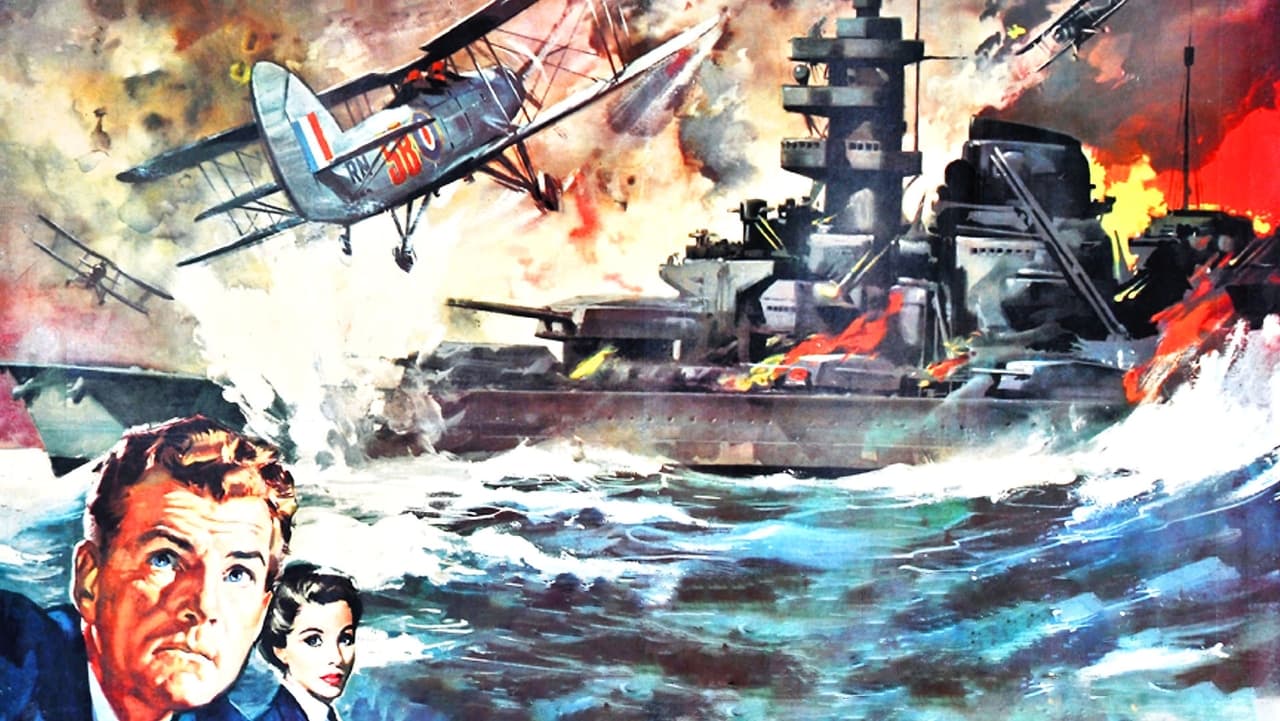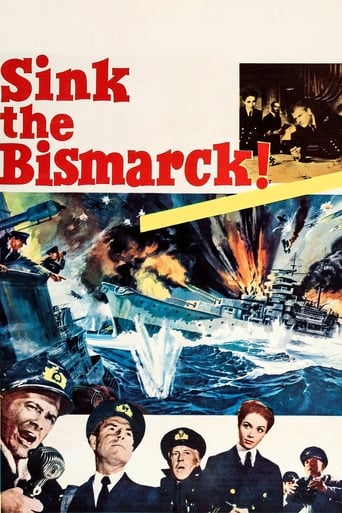

Plot so thin, it passes unnoticed.
... View MoreBetter Late Then Never
... View MoreGood films always raise compelling questions, whether the format is fiction or documentary fact.
... View MoreGreat example of an old-fashioned, pure-at-heart escapist event movie that doesn't pretend to be anything that it's not and has boat loads of fun being its own ludicrous self.
... View MoreI may be one of those few who think that a more exciting flick about the Bismarck would have been achieved had those making this movie stuck to the real story and focused entirely on it. Not that I am against the "human touch" or romantic love in films like this, but I think the Bismarck saga is a far more exciting war epic that is shown in STB! and so deserves the whole and undivided attention of an audience.First, to back my point, some facts that I don't see much mentioned, yet which are essential to the story: a) The Bismarck losing the shadowing cruisers had nothing to do with Lutjens' brilliancy and everything to do with luck. Both ships started zigzagging out of fear of possible U subs nearby so they went for 10 mins. to left, then 10 mins. to right, so every time they reached the most outward points they lost the Bismarck for a few minutes. It was during one of these occasions that, coming back, they realized they hadn't her anymore in their screens. b) The Bismarck being located again wasn't either the result of any brilliant hunch but simply the fruit of Lutjens's pessimism and of his overestimation of the British radar—he gave it a range bigger than it really had—belief which made him think that he still had them in his wake when he sent to Paris a 30 min. message depicting in detail past events, giving the Brits time enough to locate his ship through radiogoniometers--not that the Brits did any better then: they fumbled the data and gave the Germans yet another crucial advantage which was eventually neutralized by the torpedo hit on the rudder. (By then they knew she was going to St. Nazaire anyway, the closest friendly port, sort of, where the Germans could fix a +50.000-ton ship.)c) Speaking of which, that torpedo hit on the rudder could have never happened: as HMS Ark Royal was rushing to the scene she was spotted by U 556, which could have readily sunk her with torpedoes. But it didn't do it because it didn't have any left, it had just spent them all.d) The Bismarck was a condemned ship anyway as his design was already outdated, the result of Germany having been prevented from developing any serious naval research during wars. The result of it were dramatic: use of dual main batteries while other navies were already working with triple or quadruple batteries. Lack of dual purpose secondary guns, for both surface and AA fire. Great amount of room on decks wasted on lifeboats--instead of inflatable boats--room that could have been better spent on AA guns of all calibers, their failure at shooting down even one Swordfish WWI relic makes this point well.e) On the plus side, a few advantages that even if very impressive wouldn't have made a difference: it could fire her 15" much faster than her RN opponents, one shot every 22 seconds.--acc. to Von Mullenheim Rechberg--to one each 45 sec. Superb fire control, with the best optical instruments available at the time. And Krupp steel of course.As space runs out I resume: not really a very accurate reenactment of a true life event as the other More historical flick was, much more of a war propaganda movie with a human touch. Yet still very aptly done and more entertaining than it seems, with More and the rest playing it to a tee. Some superfluous melodrama, though, in a few scenes. And as in ANTR it takes you to the heart of the action on the condition that you know little or nothing about the subject matter. The less you know about it the more chances you'll have to enjoy it. 7/10.
... View MoreSINK THE BISMARCK! is a solid British WW2 movie about the hunt for the German battleship and the efforts of the British navy to destroy it. What I liked about this film was the direction, by THE SPY WHO LOVED ME's Lewis Gilbert; he gives it a stark look enhanced by the black and white photography, and helps to make this a film full of documentary realism particularly in the battle scenes.Not that this is a pure action film, because a lot of it is about the logistics of mounting a full-scale operation to pinpoint and attack a battleship. To this end we get an absolutely huge cast of British performers that acts as a genuine who's who of British cinema at the time. The cast ranges from the solid Kenneth More and Laurence Naismith as the leads to the likes of British film regulars Sam Kydd and Michael Ripper playing cameos. The film I can most liken this to is A NIGHT TO REMEMBER, a similar documentary-style film about the sinking of the Titanic, also starring More.
... View MoreVery early in this movie I could feel the tension in that plotting room, and realise that the cast and crew had captured all the drama, the surprises, the realities, and sometimes, some emotion too.Kenneth More as the newly appointed director of the op's room is a stickler for discipline. He expects all the rules of the Navy to be observed and he doesn't hesitate to tell people off if they transgress.All the acting is superb, I feel like I'm really there too. As the new information comes in and we see the situation develop. We all know the basic story, and the outcome, but this movie goes into the hard work and hard thinking that ensured the final result. The initial planning of the German Navy was over-ambitious? Surely they knew that unless one has a secure coastline, with well equipped bases all over the place, then a Navy is a bit of a waste of time, and effort? Britain had all that, and had the tradition of centuries, and knew how to use it (mostly - the later demise of Prince of Wales near Singapore showed how narrow the thinking was?). Perhaps silly Hitler just assumed that the world power he was aiming at, just HAD to have a big navy? Raeder and other admirals should have advised him?Later in the movie, we see the officers of both sides staring across the ocean at their target - a target that has BIG guns pointing straight at them, ones that when the puff of smoke comes, means that very soon, a huge shell will come screaming straight at them and their comrades - that must have been so scary. The British knew that their "Hood" had been sunk, would they soon be next? And the Germans knew they were hopelessly outnumbered and out-gunned.In some respects, perhaps the whole incident has been over-rated? Was the Bismarck such a terrible threat? I don't recall ever seeing any attempt at a "what-if", ie, if the ships had got to Brest, would they ever have been able to get out again? The British would have lost a lot of aircraft and crews as they attacked, (as they did against the other German ships there) but my guess is that the idea of using battleships to attack the convoys was fatally flawed both from that "bases" point, and also from the "resupply" issues.Germany did arrange for tankers and other ships to meet Bismarck for fuel, ammunition, food, but, the British, through the Enigma cracking, knew where these ships were, and simple sunk them - later. If Bismarck had not been damaged and sunk, perhaps it might have done some damage, but then, would have to return to Brest... and stay there (Yes, but the other ships did scoot through the Channel later)I've read somewhere that half of Germany's submarines never even saw a target ship! So, would the surface ships do any better? Maybe, maybe not? We'll never know.Something else that if different, is the quality of the acting. I've seen other movies from that era and been so disappointed by the Stewart and Niven and others. Is this a difference between Hollywood and Britain? Maybe. Much much later (2001!) Robert Redford, in a DVD bonus feature of "Spy Game", says, (of Catherine McCormack) ..."She has the benefit, as so many English actors have, of... craft, of solid training". So very true.
... View MoreA couple of the comments on here are probably well meaning but show a lack of detailed knowledge.mikestollov comments: The Bizmark chose it's battles very well, avoiding conflict with Royal Navy warships that could do it actual damage. She was a commerce raider, praying on defenceless merchant ships, less powerful warships & fleeing from anything that could do her harm. The fact that she came up against warships that could actually do damage to her was down to the doggedness of the Royal Navy. At first she did prevail, but once more due to the opposition she was given. HMS Hood was definitely NOT a good choice for this conflict, she was NOT a Battleship, she was an old, thinly armoured Battle Cruiser & well below the standard of Bizmark, her guns were inaccurate & her armour wasn't up to the threat she was faced with." Well, firstly, Bismarck never caught any merchant ship, defenceless or otherwise.Secondly HMS Hood wasn't a new ship like Bismarck, she was over 20 yrs old, however due to the Washington Naval Treaty, the RN only had four newer battleships than Hood - KGV, PoW, Rodney and Nelson. The last two of these were much slower than Bismarck, because the design sacrificed speed for armour. Meanwhile, bkoganbing from Buffalo, New York says: "Unfortunately some lessons were not learned by the British command and the Prince of Wales and the Repulse were sunk several months later by the Japanese with aerial bombardment when they reported for duty at the British base in Singapore. The British did in fact experiment with carriers as the Ark Royal's contribution in that action and others signifies. I'm willing to bet Mr. Churchill wished he had a few more carriers like the Americans and Japanese did." Well, Force Z's carrier ran aground off Sri Lanka, that's why they was no air cover. Although doctrine at the time didn't accept that a battleship was unable to survive in the open sea without air cover. The sharpest needle, though, was Japan's Yamamoto. He spotted the effectiveness of the raid from HMS Illustrious on Taranto in Nov 1940, and used rather more planes in Dec 41 at Pearl Harbor.Within the film itself the reference to Scharnhorst and Gniesenau reflects RN real concerns, but it implies that they are capital ships of a similar capability to the RN, if not to Bismarck. Scharnhorst and Gniesenau were lightly armed, with only 11" guns, on the two occasions they engaged RN capital ships, together in 1940 during the invasion of Norway, and Scharnhorst alone in 1943, they were ineffective: HMS Renown engaged both ships in 1940: in 1943 the KGV-class Duke of York sank the Scharnhorst off North Cape. There were other instances when S&G deliberately avoided engagement with old RN ships, including HMS Ramilies and HMS Malaya (both these ships had fought at Jutland in 1916!).
... View More